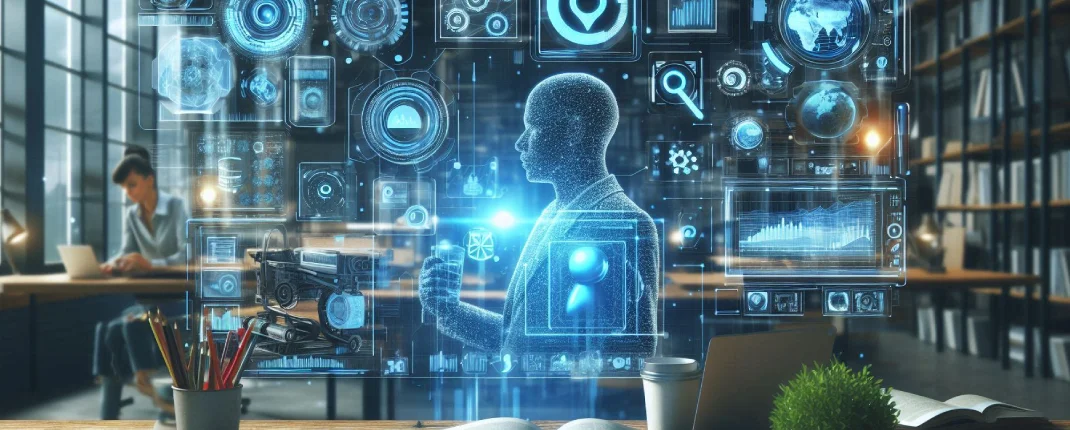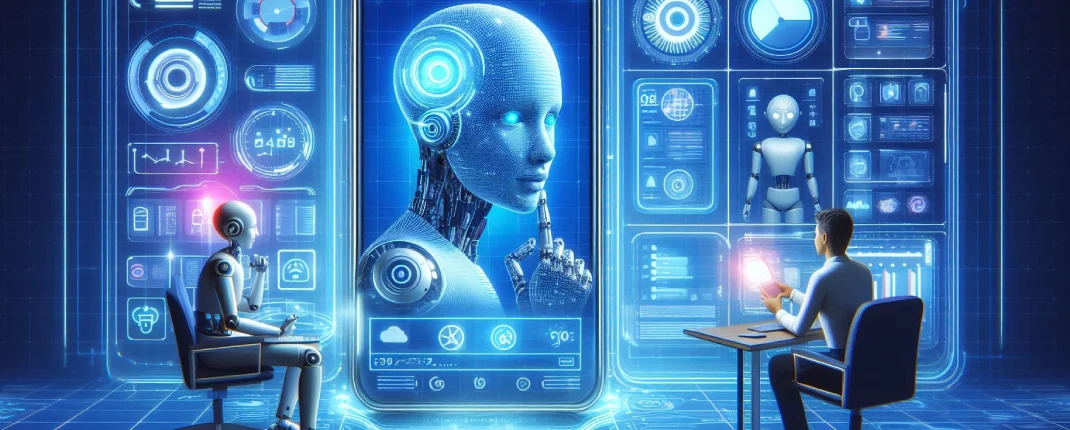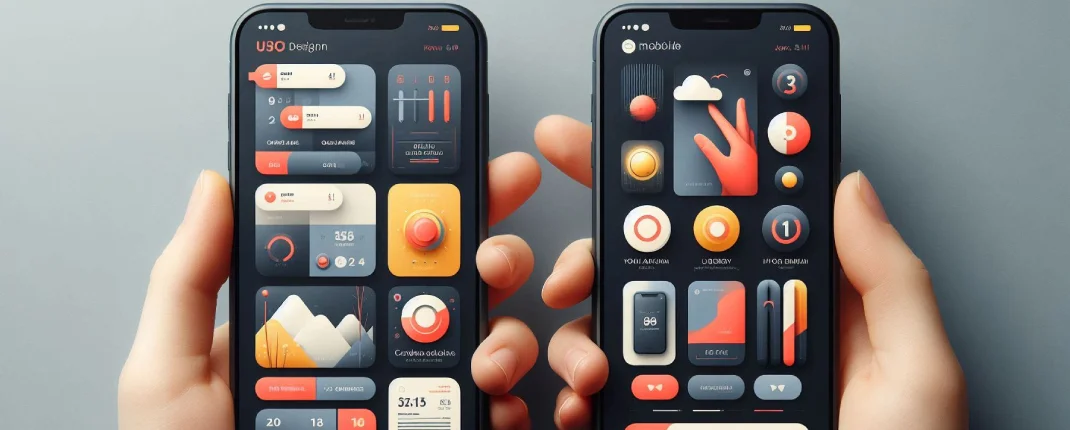
Anchal Sharma
5 min read
Introduction
In recent years, the fields of artificial intelligence (AI) and user interface/user experience (UI/UX) design have seen significant advancements and growth. With the potential to revolutionize the way we interact with technology, AI has become a key player in the design world. As we look towards the future, it's clear that the integration of AI and UI/UX will continue to shape and transform the design landscape.
In this article, we will explore the evolving relationship between AI and UI/UX and how it is set to impact the way we design in 2024 and beyond. From the potential for more personalized and intuitive user experiences to the ways in which AI can enhance the design process, we will delve into the exciting possibilities that lie ahead.
Join us as we take a closer look at the ways in which AI is changing the way we design and the potential implications for the future.
The Future of Design: AI and UI/UX in 2024

The world of design is constantly evolving, with new technologies and trends emerging every year. In the next five years, the design industry is set to experience a major transformation with the integration of Artificial Intelligence (AI) and User Interface/User Experience (UI/UX) design. These two powerful forces will shape the future of design and impact the way we interact with products and services.
Here are some key points on how AI and UI/UX will influence design in 2024:
-
Personalized user experience
With the help of AI, designers will be able to create highly personalized user experiences. AI algorithms will analyze user data and behavior to create tailored designs that cater to the individual needs and preferences of each user.
-
Seamless integration of AI and UI/UX
In the near future, AI and UI/UX will work hand in hand to deliver a seamless user experience. AI will provide the intelligence and data analysis, while UI/UX will focus on creating visually appealing and user-friendly interfaces.
-
Simplified design process
The integration of AI and UI/UX will streamline the design process, making it faster and more efficient. AI-powered tools will assist designers in creating prototypes, conducting user testing, and making design decisions.
-
Design thinking with AI
Design thinking is a human-centered approach to problem-solving. With the help of AI, designers will be able to apply this methodology on a larger scale, gaining insights and understanding user needs on a deeper level.
-
Designers as strategists
As AI takes over routine design tasks, designers will have more time to focus on strategic thinking and problem-solving. They will be seen as strategists, working closely with AI to create innovative and user-centric design solutions.
-
Better accessibility and inclusivity
With AI and UI/UX, designers will be able to create more accessible and inclusive designs. AI-powered tools will assist in identifying and addressing potential barriers for people with disabilities, making products and services more inclusive for all.
-
The rise of voice and gesture-based interfaces
In the next five years, we can expect to see an increase in the use of voice and gesture-based interfaces. With advancements in AI, these interfaces will become more accurate, intuitive, and natural to use.
-
Augmented and virtual reality
AR and VR are already making waves in the design industry, and their impact will only continue to grow in the future. With AI, designers will be able to create more immersive and interactive experiences for users.
-
Data-driven design decisions
AI will provide designers with valuable data and insights that will influence their design decisions. This will help in creating designs that are not only visually appealing but also based on user behavior and preferences.
-
The human touch
Despite the integration of AI and UI/UX, the human touch will still be crucial in design. AI may assist in creating designs, but it cannot replace human creativity and empathy. Designers will continue to play a significant role in creating meaningful and impactful designs.
How AI is Revolutionizing the Design Process?

Artificial intelligence (AI) has transformed almost every industry, and the design world is no exception. With advanced algorithms, machine learning, and natural language processing, AI is revolutionizing the design process in ways that were once thought impossible. Let's explore how AI is changing the game for designers and creatives.
-
Improved Efficiency
One of the biggest benefits of AI in the design process is its ability to improve efficiency. With AI-powered tools, designers can automate repetitive tasks, such as resizing images or creating layouts, allowing them to focus on more creative and high-value tasks. This not only saves time but also reduces the risk of human error, resulting in more accurate and consistent designs.
-
Personalization
AI has made it possible for designers to create personalized designs at scale. By analyzing customer data and behavioral patterns, AI can generate customized designs that cater to each individual's preferences and needs. This has been particularly useful in fields like marketing and advertising, where personalized designs can have a significant impact on consumer engagement and conversion rates.
-
Predictive Design
With AI, designers can now use predictive design techniques to anticipate future trends and preferences. By analyzing past design data and consumer behavior, AI can predict the colors, patterns, and styles that will be popular in the future. This allows designers to stay ahead of the curve and create designs that are more likely to resonate with their target audience.
-
Enhanced Creativity
Contrary to popular belief, AI is not here to replace designers; instead, it is here to enhance their creativity. With AI-powered tools, designers can experiment with new ideas and designs faster and more efficiently. This allows them to explore more creative avenues and come up with innovative designs that they may not have thought of otherwise.
-
Improved User Experience
AI has also brought significant improvements to the user experience (UX) design process. By analyzing user behavior and feedback, AI can identify pain points and make suggestions for improving the design. This ensures that the final product is not only visually appealing but also user-friendly and intuitive.
-
Collaboration
AI-powered design tools have made it easier for designers to collaborate with each other and with other teams. With cloud-based AI platforms, designers can work on the same project simultaneously, regardless of their location. This has streamlined the design process and improved communication and efficiency within design teams.
-
Accessibility
Inclusivity and accessibility have become critical factors in the design process, and AI has made it easier for designers to create designs that are accessible to all. With AI tools, designers can test their designs for accessibility and make necessary adjustments to ensure that everyone can access and use their designs.
-
Cost-Effective
AI-powered design tools are not only efficient but also cost-effective. By automating repetitive tasks and streamlining the design process, businesses can save time and money. This is particularly beneficial for small businesses and startups with limited budgets, as they can now create professional designs without hiring expensive design agencies.
The Impact of AI on UI/UX Design

-
Enhanced User Experience
AI-powered UI/UX design can significantly improve the overall user experience by providing personalized and intuitive interactions. AI algorithms can analyze user behavior and preferences to create a tailored experience for each individual, making the design more user-friendly and efficient.
-
Data-Driven Design
With AI, designers can gather and analyze vast amounts of data to gain insights into user behavior, preferences, and pain points. This data-driven approach allows for the creation of more effective and targeted designs, resulting in better user engagement and satisfaction.
-
Automation of Repetitive Tasks
AI can automate repetitive tasks involved in the design process, such as creating wireframes, mockups, and prototypes. This saves designers time and allows them to focus on more creative and complex tasks, resulting in faster and more efficient design processes.
-
Voice and Gesture-Based Interfaces
The rise of AI has also led to the development of voice and gesture-based interfaces, making the user experience more natural and intuitive. With AI-powered voice recognition and motion sensing technology, users can interact with the interface in a more seamless and hands-free manner.
-
Personalization
AI-powered UI/UX design can personalize the experience for each user based on their preferences, behavior, and past interactions. This not only enhances the user experience but also helps businesses to build stronger relationships with their customers and improve brand loyalty.
-
Predictive Capabilities
AI algorithms can predict user behavior and anticipate their needs, making the interface more proactive and responsive. This can result in a smoother user experience, as the design can adapt to the user's actions and provide relevant information or options in real-time.
-
Efficient User Onboarding
With AI, designers can create onboarding processes that are tailored to each user, making it easier for them to understand and navigate the interface. This can reduce the learning curve and increase user adoption, resulting in a more positive user experience.
-
Accessibility
AI-powered design can also make interfaces more accessible for users with disabilities. By analyzing user behavior and preferences, AI algorithms can adapt the design to cater to the specific needs of individuals with different abilities, ensuring a more inclusive experience for all users.
-
Continuous Improvement
AI-powered design allows for continuous improvement and optimization of the user experience. With the ability to gather and analyze data in real-time, designers can identify areas for improvement and make adjustments accordingly, resulting in a more seamless and user-friendly interface.
-
Integration with Emerging Technologies
AI is also playing a significant role in the integration of emerging technologies such as augmented reality (AR) and virtual reality (VR) into UI/UX design. This can create immersive and interactive experiences for users, taking the design to the next level.
Enhancing User Experience through Artificial Intelligence
-
Personalized Recommendations
Artificial intelligence (AI) can analyze user data and behavior to provide personalized recommendations, enhancing the user experience.
-
Chatbots
Chatbots use AI to interact with users in a conversational manner, providing quick and efficient customer service and support.
-
Voice Assistants
Voice assistants, such as Amazon's Alexa or Apple's Siri, use AI to understand and respond to user commands, making it easier for users to access information and complete tasks.
-
Predictive Search
AI-powered predictive search technology can understand user intent and provide more accurate and relevant search results, improving the overall user experience.
-
Customized Content
AI algorithms can analyze user preferences and behavior to deliver customized content, such as news articles or product recommendations, to enhance user engagement.
-
Visual Recognition
AI-powered visual recognition technology can analyze images and videos to provide users with relevant information and recommendations, making the user experience more interactive and engaging.
-
Personalized Advertising
AI can analyze user data to deliver targeted and personalized advertisements, making them more relevant to the user and enhancing the overall experience.
-
Automated Decision Making
With AI, systems can make automated decisions based on user data and behavior, streamlining processes and making the user experience more efficient.
-
User Behavior Analysis
AI can analyze user behavior and patterns to identify areas for improvement, allowing businesses to make changes and enhance the user experience.
-
Continuous Learning
AI-powered systems can continuously learn from user interactions and feedback, allowing for constant improvement and enhancement of the user experience.
Also Read : How to Leverage AI in IoT App Development for Smarter Automation
Conclusion
In conclusion, the symbiotic relationship between AI and UI/UX design is reshaping the landscape of digital experiences, presenting a transformative wave in how we interact with technology. The integration of AI into the design process is not just about automation but about unlocking new possibilities, making designs more personalized, efficient, and user-centric. As we look ahead to 2024, the dynamic evolution of AI in UI/UX promises a future where design is not only visually appealing but also seamlessly tailored to individual preferences and needs.
Looking to harness the power of AI and elevate your digital experiences?
Trust Whiten App Solutions , a leading software development company at the forefront of innovative solutions. Our team combines expertise in AI and UI/UX design to deliver cutting-edge applications that resonate with users. Explore a new era of design possibilities with Whiten App – where creativity meets technology.
Visit us today to embark on a journey of transformative design.
FAQs
-
How is AI changing the way we design?
AI is changing the way we design by making the process more data-driven and efficient. It can analyze large amounts of user data and provide insights that can inform design decisions. AI is also being used to automate certain design tasks, freeing up designers to focus on more creative aspects.
-
How is AI improving user experience?
AI is improving user experience by personalizing it for each individual user. Through data analysis, AI can understand users' preferences and behaviors, allowing for a more tailored and intuitive experience. AI can also anticipate user needs and provide proactive solutions, making the overall experience more efficient and satisfying.
-
What are some potential challenges or concerns with the increasing use of AI in UI/UX design?
One concern is the potential for AI to perpetuate biases and discrimination. If the data used to train AI systems is biased, it can result in biased design decisions. Another challenge is the need for designers to understand and have control over the AI systems they are using, in order to ensure the best user experience. Additionally, there may be ethical considerations when it comes to the use of AI in design, such as the protection of user data and privacy.

